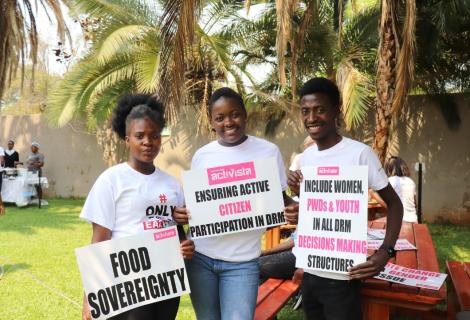GOVERNMENT OF ZIMBABWE URGED TO FINALISE THE DISASTER RISK MANAGEMENT BILL

Press Statement
22 March 2023 -Activista Zimbabwe Chapter calls on the government of Zimbabwe to finalize the Disaster Risk Management and Civil Protection (DRM) Bill. Zimbabwe is still using the reactive Civil Protection Act of 1989 which does not adequately address DRM issues. Moreover, the disaster risk governance framework is inadequate on issues such as allocation of resources to lower tiers of government, unsafe land use practices and disjointed disaster management coordination. We note that local response structures are largely reactive to disasters in line with the Civil Protection Act. Furthermore, people with disability, youth and women are not included in the current DRM structures from national to district. While being cognizant of the fact that the cabinet approved principles of the DRM bill on 7 June 2022, we are concerned by the continued delays in finalizing the bill.
In 2019, Cyclone Idai hit Zimbabwe killing over 300 people, leaving 325 people missing and displacing 4000 people. Idai also destroyed infrastructure worth close to USD650 million (Matsvange et al 2021; World Bank). Since 2019, the Southern Africa region has been experiencing repeated threats from cyclones and tropical storms such as Cyclone Chalene in 2020, Cyclone Eloise of 2021, Tropical Storm Anna in 2022 and now Tropical Storm Freddy in 2023. There were also several cyclones/tropical storms that formed and ended in the Indian ocean during these years. According to Southern Africa Regional Specialized Meteorological Centre (RSMC)(2022) report, the 2021/2022 cyclonic season produced 12 named storms, with five becoming tropical cyclones. For the 2022/2023 Southern Africa cyclonic season (November 2022 to April 2023), there is 60% probability of normal to below normal cyclone activity expected over the Southwest Indian Ocean (SWIO) basin, with an anticipated 6–10 named storms and the potential for 3–5 reaching tropical cyclone intensity. Communities affected by previous cyclones are still to recover from psycho-social issues and ill health. For instance, people that were exposed to horrific scenes during loss of their loved ones were still traumatised.
Apart from Cyclones, Zimbabwe continues to face disastrous droughts since the 1980s. According to the Southern Africa Drought Resilience Initiative (SADRI) (2022), severe drought episodes have been observed in Zimbabwe in 1991-1992, 1994-1995, 2002-2003, 2015-2016 and 2018-2019.
Considering this background and the fact that Zimbabwe is party to the Sendai Framework, we call upon the government to;
• Share with concerned stakeholders a clear roadmap on the key milestones towards the finalization of Disaster Risk Management bill.
• Make it mandatory for the national and lower tiers of government to set aside at least 3% of total budgets for disaster risk management fund.
• Purchase all-terrain vehicles and graders for easy access and reconstruction purposes.
• To reconstruct and rehabilitate community-based DRM systems and building the capacity of traditional leaders.
• Include Disaster Management in school curriculum.
• Invest in modern early warning systems and the institutionalization of Indigenous Knowledge Early Warning Systems.
• Set up social and child protection systems that make the replacement of lost identity documents, health cards and cash transfer modalities sensitive to disaster situations.
• Consider Rural and Urban Settlement policy to regulate planning.
• Develop a policy on setting standards in the development of infrastructure. The policy should ensure that housing structures are built to a standard that can withstand harsh conditions.
For more details please contact:
ActionAid Zimbabwe Country Director, Joy Mabenge: Email joy.mabenge@actionaid.org or Mobile +263 772904479
Twitter: https://twitter.com/ActionAidZim
Facebook: https://www.facebook.com/ActionAidZimbabwe/
Website: https://zimbabwe.actionaid.org/
ENDS//